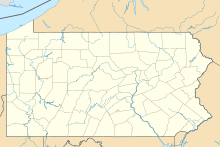Fort Pitt Museum
| Established | 1969 |
|---|---|
| Location | Pittsburgh, Allegheny County, Pennsylvania, United States |
| Coordinates | 40°26′26″N 80°00′34″W / 40.44064°N 80.00957°WCoordinates: 40°26′26″N 80°00′34″W / 40.44064°N 80.00957°W |
| Curator | Heinz History Center / Pennsylvania Historical and Museum Commission |
Fort Pitt Museum is an indoor/outdoor museum that is administered by the Senator John Heinz History Center in downtown Pittsburgh, Allegheny County, Pennsylvania in the United States. It is at the confluence of the Monongahela and Allegheny Rivers, where the Ohio River is formed. Fort Pitt Museum is surrounded by Point State Park, a Pennsylvania state park named for the geographically and historically significant point that is between the rivers. This piece of land was key to controlling the upper reaches of the Ohio River Valley and western Pennsylvania, before, during and after the French and Indian War as well as the American Revolution.
The museum is in a recreated bastion of Fort Pitt, which was originally built in 1758 by the British. An outline of Fort Duquesne is nearby. The historical focus of the museum is the role that Fort Pitt played during the French and Indian War. The museum also features detailed information on Fort Pitt's role during the American Revolution, the Whiskey Rebellion and the founding of Pittsburgh. The museum was established and operated by the Pennsylvania Historical and Museum Commission until its closure in August 2009 from state budget cuts. The Heinz Center took over operation of the museum and reopened it in April 2010.
Fort Pitt was a fort in what is now the city of Pittsburgh, Allegheny County, Pennsylvania. The fort was built in 1758 during the French and Indian War, next to the site of Fort Duquesne. The French built Fort Duquesne at the beginning of that war, and it became a focal point due to its strategic river location. The Braddock expedition, a 1755 attempt to take Fort Duquesne, met with a bloody repulse at the Monongahela River. The French garrison viciously mauled an attacking British regiment in September 1758, but abandoned and destroyed the fort at the approach of General John Forbes's expedition in November.
...
Wikipedia

